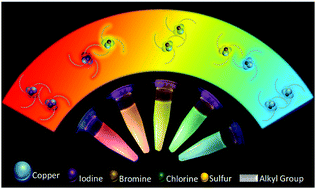Achieving full-color emission of Cu nanocluster self-assembly nanosheets by the virtue of halogen effects†
Abstract
Fluorescent Cu nanoclusters (NCs) have shown potential in lighting and display, because Cu is cheap and easily available. Despite recent successes in improving the emission intensity of Cu NCs on the basis of aggregation-induced emission enhancement and self-assembly-induced emission enhancement, the difficulty in tuning the emission color sheds the doubt for achieving high-performance white light-emitting diodes (WLEDs). In this work, halogen effects are utilized to tune the emission color of Cu nanocluster self-assembly nanosheets (NSASs). By altering the adsorbed halogens from Cl, Br to I, the emission peak of Cu NSASs is tunable from 495 to 674 nm. In this context, halogen atoms are capable of improving the charge transfer and molecular spin coupling of Cu NCs, and thereby narrow the S0T1 gap and facilitate the intersystem crossing of excitons from a singlet to triplet state. As a result, emission spectra redshift and the population of the exiton recombination via the triplet state pathway is increased, which leads to the improvement of the photoluminescence quantum yield (PLQY). By simply introducing and/or mixing different types of cuprous halides, Cu nanocluster co-assembly nanosheets (NCASs) with full-color emission are obtained. The as-prepared Cu NSASs and NCASs are further employed to fabricate monochrome and white LEDs.



 Please wait while we load your content...
Please wait while we load your content...